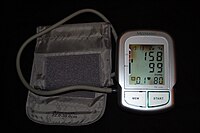
Photo from wikipedia
INTRODUCTION Children with neurogenic bladder (NGB) often require a lifetime of clean intermittent catheterization (CIC), typically using uncoated catheters (UCs). Hydrophilic catheters (HCs) have lower friction than UCs with reported… Click to show full abstract
INTRODUCTION Children with neurogenic bladder (NGB) often require a lifetime of clean intermittent catheterization (CIC), typically using uncoated catheters (UCs). Hydrophilic catheters (HCs) have lower friction than UCs with reported less damage to the urethra. The purpose of this study is to compare outcomes between these catheters. METHODS An investigator-initiated, prospective, randomized clinical trial was conducted to compare HCs versus UCs. Children aged 2-17 years with NGB on CIC were enrolled for 1 year. Block randomization was used. Dexterity scores were obtained in those who perform self-catheterization. Outcomes were UTI, difficulty passing the catheter, urethral injury, and patient satisfaction. RESULTS Demographic data is presented in the Table. Seventy-eight patients were enrolled. Age and gender were similar between the groups. Fifteen patients in each group performed CIC via an abdominal wall stoma. Eight and 15 patients withdrew from the UC and HC groups, respectively. The HC group overall had more problems with the catheter, mainly difficulty with handling. There were no differences for passing the catheter, pain, hematuria, or urethral injuries. There were two urinary tract infections (UTIs) in two HC patients and 17 UTIs in seven UC patients (p = 0.003). Patients with UTIs in the HC group went from 16% in the previous year to 5% during the study. Three children in the HC group had three or more UTIs in the year before enrollment and none during the study. The patients that completed the study with HC were overall satisfied and many requested to continue with the HC. CONCLUSIONS HCs may decrease the risk of UTI in children with NGB. Urethral complications were low in both groups. Most HC patients were pleased but some found the slippery coating difficult to handle.
Journal Title: Journal of pediatric urology
Year Published: 2017
Link to full text (if available)
Share on Social Media: Sign Up to like & get
recommendations!